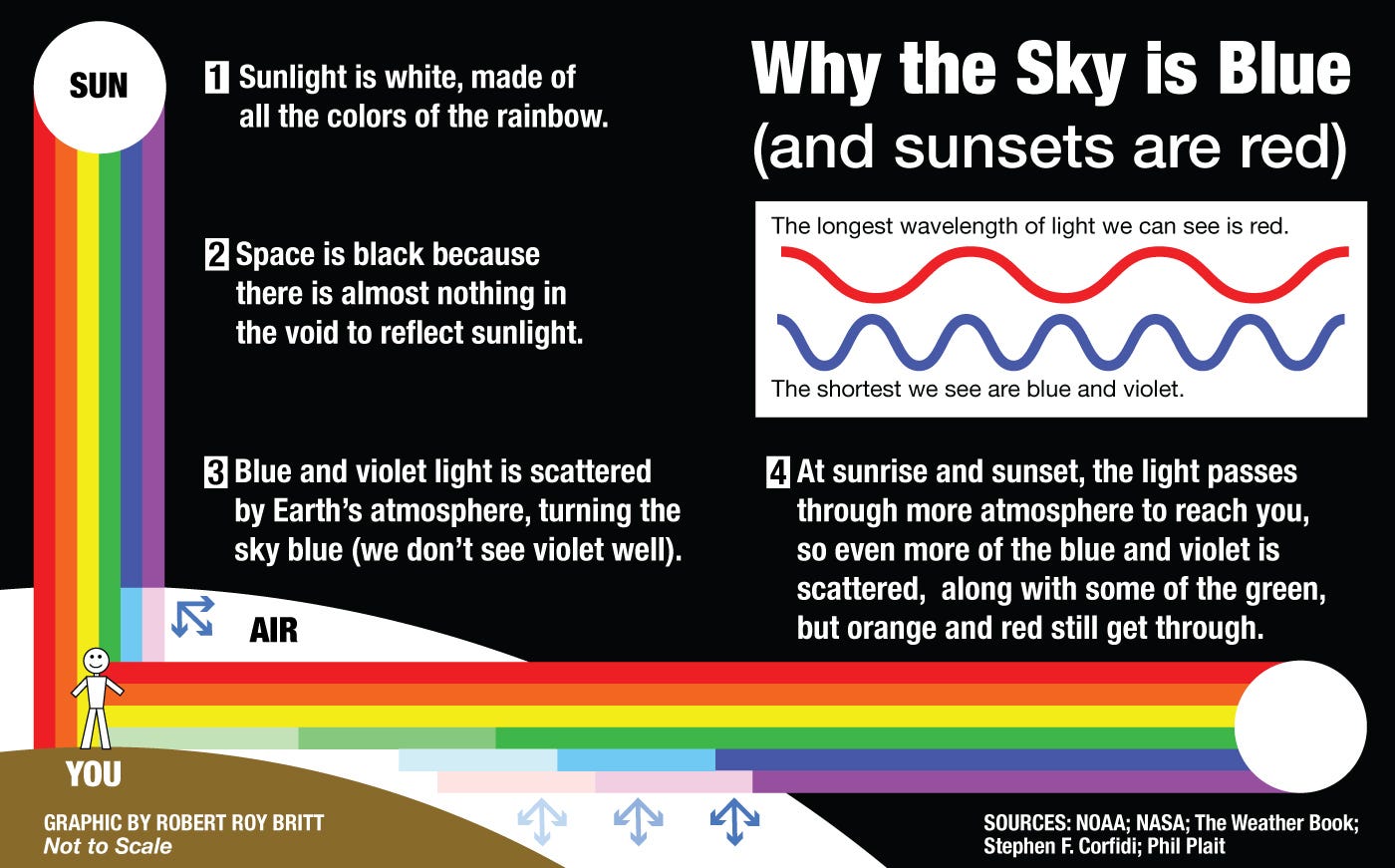The question “why is the sky blue?” has fascinated humans for centuries. While it may seem like a simple query, the answer involves a blend of physics, atmospheric science, and human perception. In this detailed article, we will explore the scientific reasons behind the sky’s blue color, delve into related phenomena, and provide a comprehensive understanding of this natural wonder.
Key Takeaways
- The sky appears blue due to the scattering of sunlight by the Earth’s atmosphere.
- Rayleigh scattering is the primary mechanism responsible for the blue sky.
- The sky can change colors at different times of the day due to varying angles of sunlight.
- Other atmospheric conditions, such as pollution and dust, can affect the sky’s color.
The Science Behind the Blue Sky
Understanding Light and Color
To grasp why the sky is blue, we first need to understand the nature of light. Sunlight, or white light, is composed of a spectrum of colors, each with different wavelengths. These colors range from red, with the longest wavelength, to violet, with the shortest wavelength.
Rayleigh Scattering
The phenomenon primarily responsible for the blue sky is known as Rayleigh scattering. Named after the British scientist Lord Rayleigh, this scattering occurs when light travels through the Earth’s atmosphere and interacts with molecules and small particles.
Rayleigh scattering is more effective at shorter wavelengths of light. Therefore, colors like blue and violet are scattered more than colors with longer wavelengths, such as red and yellow. However, our eyes are more sensitive to blue light and less sensitive to violet light, which is why we perceive the sky as blue rather than violet.
Why Does the Sky Change Colors?

Sunrise and Sunset
During sunrise and sunset, the sky often takes on hues of red, orange, and pink. This is because the sun is lower on the horizon, and its light has to pass through a greater thickness of the Earth’s atmosphere. As a result, more of the shorter wavelengths (blue and violet) are scattered out of our line of sight, leaving the longer wavelengths (red and orange) to dominate the sky’s color.
Weather and Atmospheric Conditions
Various atmospheric conditions can influence the color of the sky. For instance:
- Pollution: Particles from pollution can scatter light differently, often resulting in a hazier, less vivid sky color.
- Dust and Smoke: Similar to pollution, dust and smoke particles can scatter light in ways that alter the sky’s appearance, sometimes giving it a reddish or brownish tint.
- Water Vapor and Clouds: Water droplets and ice crystals in clouds scatter all wavelengths of light equally, which is why clouds appear white or gray.
Scientific Experiments and Observations
Historical Perspectives
Throughout history, many scientists have contributed to our understanding of why the sky is blue. Notable figures include:
- Isaac Newton: Newton’s experiments with prisms helped demonstrate that white light is composed of different colors.
- John Tyndall: Tyndall’s experiments in the 19th century furthered our understanding of light scattering in the atmosphere.
- Lord Rayleigh: Rayleigh’s theoretical work provided a detailed explanation of the scattering process now named after him.
Modern Observations
Today, scientists use advanced tools and techniques to study atmospheric phenomena. Satellites, ground-based observatories, and computer models help researchers understand how various factors influence the color of the sky and predict changes in atmospheric conditions.
Common Misconceptions
Several misconceptions about the color of the sky persist. Let’s address a few:

- Reflection from the Ocean: Some believe the sky is blue because it reflects the color of the ocean. In reality, the sky’s blue color is due to Rayleigh scattering, as explained earlier.
- Blue Filters in the Atmosphere: Another misconception is that the atmosphere contains blue particles or filters. The scattering of shorter wavelengths of light causes the blue appearance, not any specific particles.
The Importance of Understanding the Blue Sky
Understanding why the sky is blue is more than a trivial pursuit; it has practical implications in various fields:
- Astronomy: Knowledge of atmospheric scattering helps astronomers correct for atmospheric distortions when observing celestial objects.
- Climate Science: Understanding light scattering can provide insights into climate change and the impact of pollutants on the atmosphere.
- Photography and Art: Artists and photographers can use this knowledge to capture and represent the sky more accurately in their work.
The sky’s blue color is a result of the intricate interplay between sunlight and the Earth’s atmosphere, primarily driven by Rayleigh scattering. This phenomenon scatters shorter wavelengths of light, such as blue and violet, more effectively than longer wavelengths. Our eyes’ sensitivity to blue light further enhances this effect, making the sky appear predominantly blue.
By understanding the science behind the blue sky, we gain a deeper appreciation for the natural world and the complex processes that shape our everyday experiences. So, the next time you look up at the sky, you’ll know the fascinating science that paints it blue.


